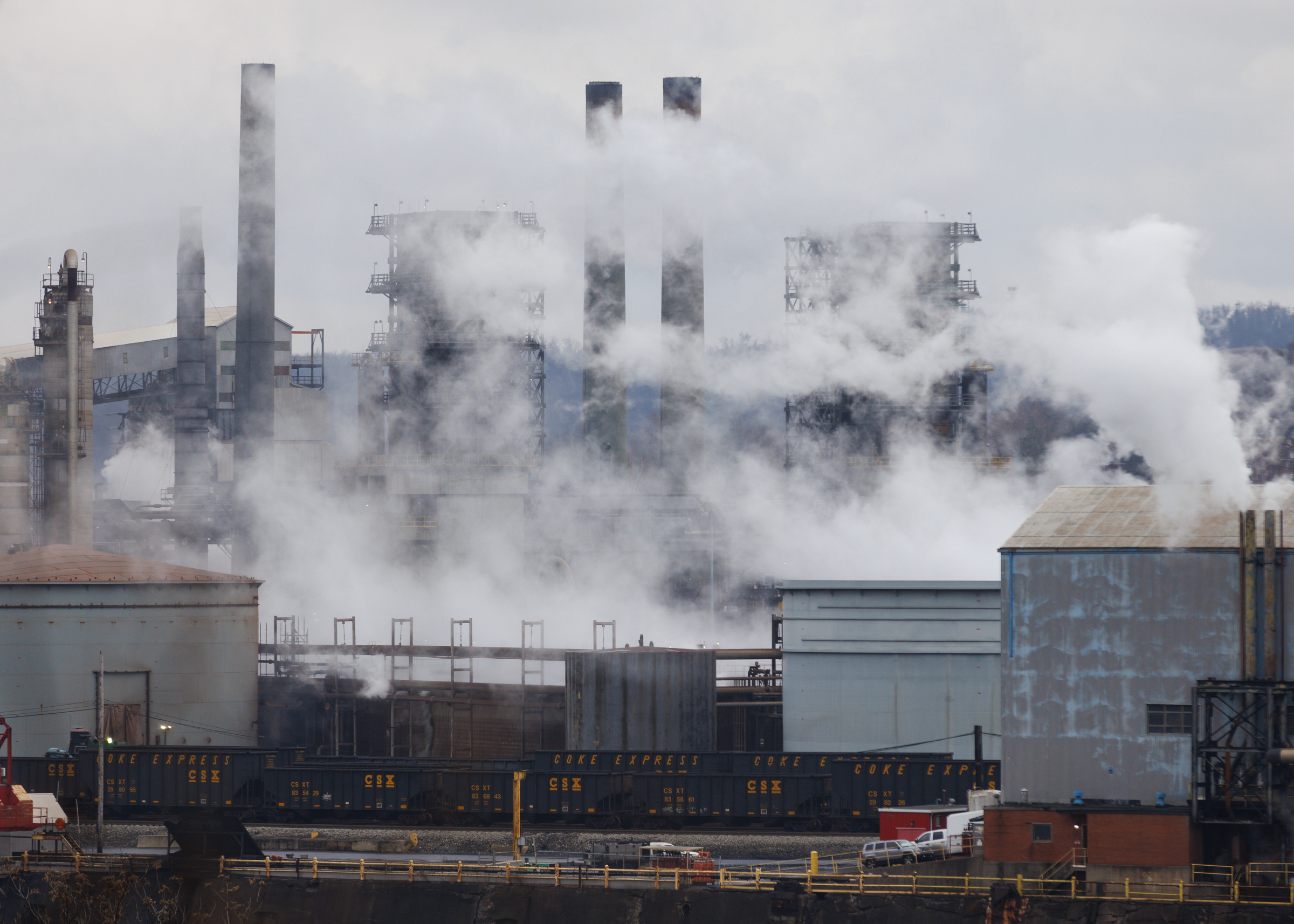[ad_1]
“I couldn’t get any air in. I took a deep breath out, and nothing was coming in,” said Qiyam Ansari, recalling his experience during an inversion in 2010 as a ninth grader with asthma living in Braddock Hills.
“I remember getting up to make a bowl of cereal. And by the time I made it to the stairs, I fell unconscious,” he told members of Allegheny County Council’s Committee on Health and Human Services Tuesday, during a special hearing convened to update council of the county’s air quality regulations and the efficacy of the Mon Valley Episode Rule.
“By the time I got to McKeesport Hospital, which was five minutes away, I was pronounced dead,” Ansari continued. After a lifeflight to Children’s Hospital and a medically-induced coma, he was told by doctors that his lungs were functioning at 60% capacity, and that if it happened again, they weren’t sure that he’d survive.
“I was only exposed to the air for less than 24 hours,” said Ansari. “That was enough to make my lungs collapse.”
The rule, enacted in September 2021 by the Allegheny County Health Department [ACHD], aims to curb particulate pollution in the Mon Valley during inversions — a meteorological phenomenon during which air pollution is trapped at human breathing level. Under the rule, a watch is issued when the federal PM2.5 standard is forecast to be exceeded. If, during a 24-hour period, that standard is exceeded, the department issues a warning via Allegheny Alerts and pre-approved pollution mitigation plans must go into effect at 17 industrial facilities.
An asthma specialist and community advocates told the committee that by the time an air inversion warning is issued, triggering efforts to cut emissions, the damage to lungs is already done. Inversions can persist for days as a mixture of warm air and emissions are trapped in the Mon Valley, often forcing residents with conditions like asthma to stay indoors.
During the nearly two-hour hearing, council members heard testimony criticizing the effectiveness of the rule. Six speakers from a cross-section of medical, scientific and community organizing backgrounds pressed the committee for more stringent enforcement of air quality standards and for a more robust and enforceable approach to protecting public health.
Representatives of the Health Department were invited to participate in the hearing, said committee Chairman Paul Klein, D-Point Breeze, but no representatives of the department showed up.
“We’re all at risk of these adverse health effects from air pollution,” Dr. Deborah Gentile, an asthma and allergy specialist who has worked extensively with patients in the Mon Valley, told the council committee. “We really have to focus on preventing the problem.”
Data shows poor air persists during inversions in the Mon Valley
Air pollution was not reduced below the federal standard on days when the county issued a warning, according to Ana Hoffman, director of air quality engagement at Carnegie Mellon University’s CREATE Lab.
The National Ambient Air Quality Standards [NAAQS] for PM2.5, which act as the governing threshold for the rule, were exceeded on a number of occasions when a watch or warning was in place, said Hoffman. She pointed to data compiled by the Group Against Smog and Pollution [GASP] that shows exceedances of the PM2.5 standard occurred multiple days into a warning during at least two lengthy inversions in October and November.
“Unfortunately, the rule failed to prevent violations of the federal air quality standards, despite being used to its most effective capacity in the rule’s current form,” she told the committee.
CREATE Lab also looked at data from their SmellPGH odor reporting app to identify possible changes in pollution since the rule went into effect. “Looking at the 12 months prior to the rule taking effect,” said Hoffman, “frequency of odors associated with industrial air pollution show no change compared with more recent months with the rule in place.”
Generally, the persistent odor can be attributed to hydrogen sulfide [H2S], she said, which is easy to detect and “can be considered a marker for other dangerous pollutants emitted by industries in the Mon Valley.” A March 2022 report by the ACHD Air Program concluded that H2S exceedances at the department’s Liberty monitor can be “attributed entirely to emissions originating at U.S. Steel’s Clairton Plant”.
H2S is not covered by the Mon Valley Episode Rule, though Hoffman argued that it could, and should, fall under the regulation’s purview. “If the Mon Valley Episode Rule could be expanded to include the state of Pennsylvania’s ambient air standards, and not just federal standards, H2S would be covered under its supposed public health protections.”
Changing the regs, expanding the scope
Several people who spoke before council pointed to a fundamental issue with how the rule is constructed. By the time a warning is issued, prompting industry to reduce pollution, they said, the damage has already been done from a public health perspective.
“The horse is out of the barn when [the rule] comes into play,” said Gentile.
“If you have asthma, you can have minutes to hours worth of exposure to these pollution levels that could trigger an attack,” she said. “It’s not 24 or 48 hours or 72 hours. That’s too late. The exposure has already happened when the alert is going out. The health impacts are done. … That time frame is just not appropriate.”
Advocates criticized the hours and sometimes days that can pass between the start of an inversion and the imposition of mitigation measures.
“You have this period of time, it could be a day or two of high pollution exposure, before anything is even put into motion,” Matt Mehalik, executive director of the Breathe Project, told council.
“So it’s a potentially delayed start every single time?” pressed council member Michelle Naccarati-Chapkis, D-Plum, who is also the executive director of Women for a Healthy Environment.
“Every single time,” Mehalik replied.
A potential change, said Mehalik, would be to essentially skip the watch phase altogether when an inversion is forecast and issue a warning immediately, prompting mitigation plans to go into effect much sooner. “That will at least cut back on some of the exposures,” he said.
Gentile also suggested that the county adopt a more robust and accessible warning system for residents in the Mon Valley. “We need a global warning that could reach everyone,” she said. “We really need to invoke the media. You need to send out an alert. It needs to be on a radio. It needs to be coming across the TV screen as people are watching it. You want to let the schools know. You want to let senior citizen centers know.”
How can the rule be improved?
The department stated in January that an analysis of the rule is a “major goal” for 2023. Evaluation of the rule will follow a “very complicated analysis,” Rabinowitz told PublicSource, and will probably involve public input.
“Since the regulation’s adoption in September 2021, the department’s Air Quality Program has been working to ensure that the 17 facilities covered by the rule adhere to the approved mitigation plans they submitted to the department,” wrote Bureau of Environmental Health Deputy Director Geoffrey Rabinowitz in a statement emailed to PublicSource. “To date, there have been a limited number of episodes to collect data. … Our Planning and Data Analysis section [is] in the beginning stages of assessing the data to determine the overall effectiveness of the rule.”
Hoffman recommended “that ACHD go through mitigation plans site by site and quantify how each element translates into decreased production and decreased pollution.” She added that ACHD should “inspect and enforce adherence” to the approved mitigation plans while warning phases are in effect, and conduct fenceline monitoring that measures pollutants as they leave the boundary of a facility, if necessary.
The hearing is a first step in seeking public input on air quality regulations and the rule, Klein said. And as the current county administration sunsets, he said, for any new administration: “This should be on your radar. This should be a priority.”
Quinn Glabicki is the environment and climate reporter at PublicSource and a Report for America corps member. He can be reached at quinn@publicsource.org and on Twitter and Instagram @quinnglabicki.
[ad_2]
Source link


